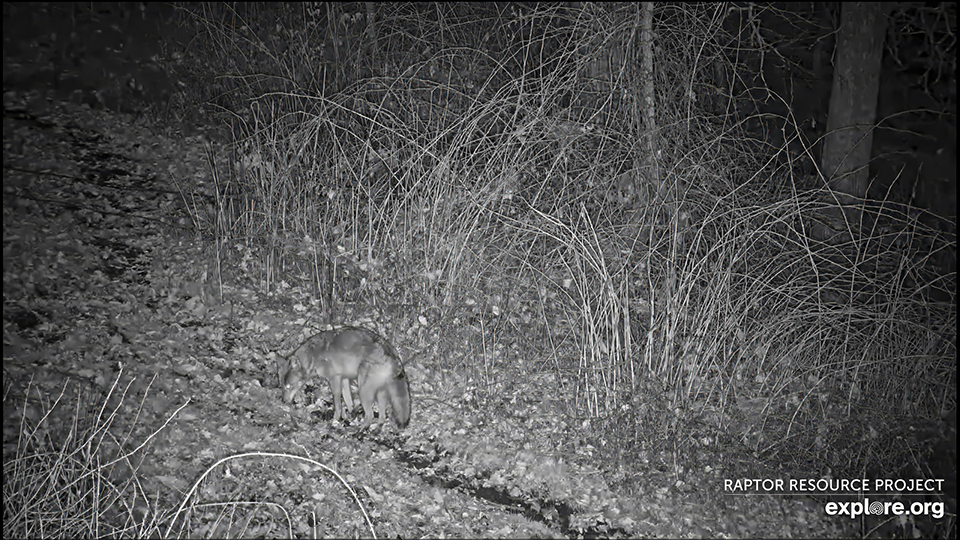Followers were so fascinated by the coyotes singing near the North Nest that I invited Janet Kessler, a coyote expert from San Francisco, to do a guest blog on them. You can learn more about her here and subscribe to her blog, Coyote Yipps, here: https://coyoteyipps.com/. Thanks for taking the time to do this, Janet – I learned a lot!
Thank you so much for sharing your live-cam video with me with the amazing coyote howls off-camera in the background! Even your two nesting eagles contributed to some sounds: they were definitely aware of it, though apparently not too concerned.
Coyotes vocalize for many reasons. Vocalization is just ONE of the ways they communicate with each other. Other ways they communicate are silently and visually through body language and eye-to-eye contact, and even silently through odors — for example, they communicate their territorial boundaries through urine scent marking.
Social Time
 Two coyote siblings hanging out together. Photo by Janet Kessler.
Two coyote siblings hanging out together. Photo by Janet Kessler.
Context is pretty important for figuring out exactly what is going on in the vocalization and we don’t have that here. For example a siren can set them off, or a dog chasing one of them will cause one to give off distressful vocalizations. But, judging by what I’ve heard before, your recording sounds like the call before the family rendezvous, which is a nightly event where they get together — after sleeping during the daylight hours, usually in separate locations — where they meet and greet and interact. There’s lots of excitement and squealing: it’s a little like a party. After this rendezvous, they’ll go off trekking through their territory, where they hunt, patrol, mark (to keep other coyotes out), and continue to socialize. This sort of rendezvous might occur several times during the nighttime.
Their sounds run the gamut from howls, yips, wines, squeals, to growls, snarls, hisses, barks, screams, moans, and purring, to name a few. From what I’ve heard in 17 years of listening to them, their vocalizations are emotive responses to situations — it’s definitely not a language, rather they emit similar sounds in similar situations, though some of these might be cultural, by which I mean they are learned and used in specific situations by specific families and not others.
Coyote Territories, Coyote Families
 March 7, 2024: Coyotes near the North Nest. Video: https://youtu.be/NpKbdd43H_k?si=6IqWoTAgXz9MMomD.
March 7, 2024: Coyotes near the North Nest. Video: https://youtu.be/NpKbdd43H_k?si=6IqWoTAgXz9MMomD.
At this time of year, mating is over and many of the females are about to (or just have) given birth. Dads will be extremely protective of their birthing and denning areas — much more so than normally — which basically means that you need to keep your dogs away from them — which should be done always. They simply want to be left alone. This protective behavior isn’t only for their own safety, but it’s to protect the scarce resources that are on each territory for themselves. Each coyote family unit lives on an exclusive territory and they keep all other coyotes out. You can imagine that they aren’t too comfortable with dogs being around. Most territories in the wild run from 4 to 8 square miles per territory. However, in the city, they run about 2.5 square miles. The family consists basically of Mom and Dad. Then, there might be pups and or yearlings who soon leave the area. I would say that most territories that I’ve seen run, population wise, from the two breeding alphas to about seven which includes pups and yearlings.
It’s important to know that these are family-minded animals: they are hugely social, interactive, and communicative, just like we are. The basis of their lives is their families and this is what they are wrapped up in. We don’t see much of their family activities because they are highly secretive — they don’t want to be seen — but also, most of their activity is at night when we aren’t around to see it or when it’s too dark for us to see it, even though they are diurnal animals like we are and CAN be seen at any time of the day. They are not nocturnal.
What Do Coyotes Eat?
People always want to know about their diets: they are opportunistic eaters and can eat just about anything! Their favorite here in San Francisco is the gophers: these are plentiful and fairly easy for them to catch. Second comes the voles. But of course, they can catch squirrels, rats, mice, birds, bugs, amphibians, meso-predators such as raccoons, skunks, and opossums, and roadkill. But they also eat vegetation of all types and fruit of all types: I’ve seen them gorge on blackberries, loquats and pears!
I hope you find this mini-post helpful. If you are interested in coyotes, you can follow me on Instagram: https://www.instagram.com/coyoteyipps/ or my blog: https://coyoteyipps.com/ where I post coyote things regularly.
 The Raptor Resource Project
The Raptor Resource Project The Raptor Resource Project
The Raptor Resource Project